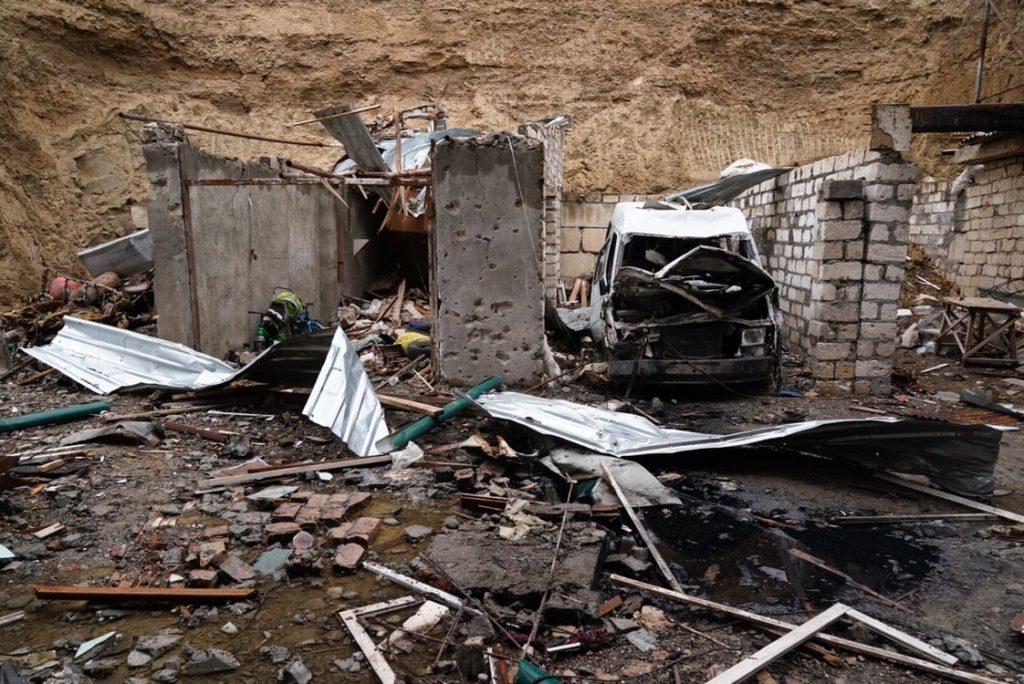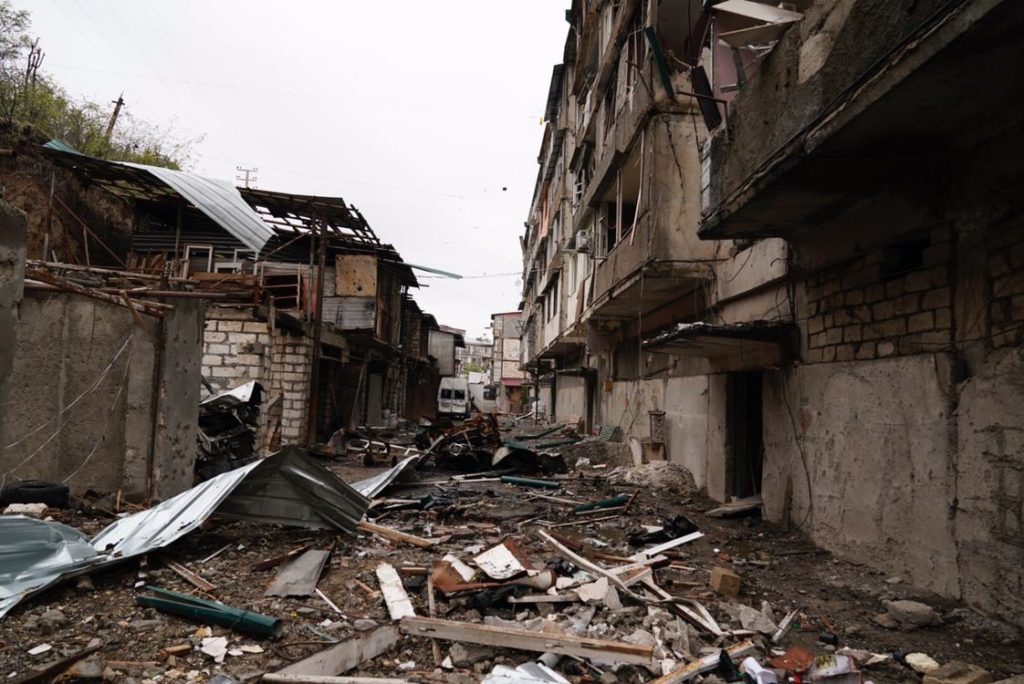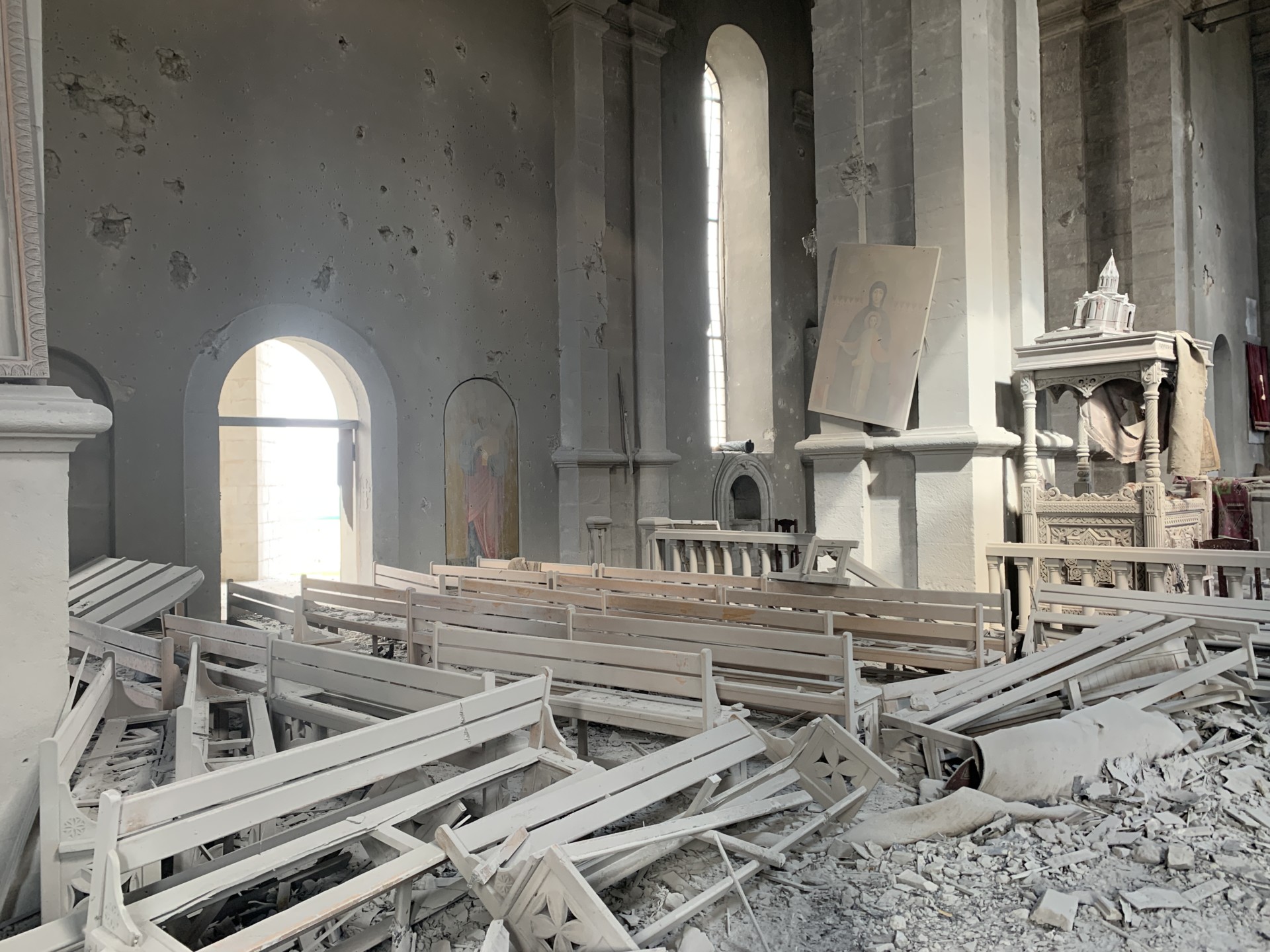This reportage was produced with support from the Pulitzer Center
The air raid sirens were blaring. An old man on the main avenue, the only person in sight, told me to cross to his side of the street. “The shells usually fall on the other side,” he said.
In Stepanakert – the now nearly empty capital of the self-styled ethnic Armenian Artsakh Republic – the remaining residents spend their nights cowering in makeshift shelters that are often little more than musty cellars under aging Soviet apartment blocks. When a volley of Grad rockets crashed into the city, buildings shuddered for miles around.
Almost a month into the war in Nagorno-Karabakh, many Armenians are starting to feel the earth shift beneath their feet as Azerbaijan’s military advances annihilate old assumptions about Armenia’s military prowess and Azerbaijan’s distaste for a fight.
For nearly three decades, Armenians have controlled not just Karabakh – a mountainous district of Azerbaijan that had a degree of self-rule during the Soviet period – but also seven formerly ethnic Azeri districts surrounding Karabakh, which it won control of when the first Karabakh war ended in 1994.
In a matter of weeks, Azerbaijan has begun reversing the conquests Armenians cemented in the early 1990s, planting flags in towns that were once populated by Azerbaijanis as well as towns within the Karabakh heartland itself where Armenians had lived continually for centuries – until just days ago.
They’ve done it with an array of modern weaponry purchased from a cast of characters as diverse as Turkey, Israel, and Russia. But it’s the drones sourced in Turkey and Israel in particular that have changed the balance of power on the battlefield. No longer are the mountains of Karabakh the Armenian fortress they once were – not when the opponent rules the sky above them.
In September, none of this was imaginable for most Armenians, whose worldview revolves around a proud past and the assumption – forged in the first Karabakh war – that they are the superior warriors. Armenia’s history is indeed ancient; it can claim relics and landmarks throughout the region that stretch far beyond its modern borders. But it is Armenia’s obsession with the past that may have caused its people to misread the threatening present.
A typical conversation between a foreigner and a resident of Stepanakert will allude to the age of the churches in the region and the religion of its adversaries in Azerbaijan. Every outsider is seen as an emissary who must be charged with the urgent task of telling the Christian world that Armenians were here first and that they’re now under attack from an Islamic horde.
It’s not unreasonable for people here to see things this way. After all, the present conflict began with pogroms against Armenians in the Azerbaijani cities of Baku and Sumgayit that were a violent response to a burgeoning Karabakh-Armenian separatist movement in the late 1980s. The memory of the Ottoman slaughter of Armenians during the 1915 genocide looms large, too.
But these painful memories obscure the more recent events that motivate Azerbaijanis to fight today. More than a few people expressed the sentiment that the Azerbaijanis “have gone completely crazy,” or asked me, “Why are they doing this?” It’s as though Armenians’ past traumas have made it harder for them to perceive Azerbaijan’s grievances and its growing willingness to sacrifice not just billions of dollars of its oil wealth for an arsenal of modern weaponry but also the lives of its soldiers and civilians.

For Azerbaijan, it’s all in the service of a cause that is seen as just. Baku’s initial grievance against Armenians was the Karabakh region’s desire to be united with Armenia. But that has since been eclipsed by anger over the expulsion of hundreds of thousands of ethnic Azeris from their homes in both Karabakh and the surrounding districts as they came under the control of ethnic Armenian forces during the first war. Since then, it has remained a central tenet of Azerbaijani state propaganda that one day they would return to their homes, no matter the cost.
Armenians who were in cities that remained under Azerbaijani control had to flee, too. In all, some 200,000 ran, compared to some 750,000 Azerbaijanis left homeless by the first war. But it’s not just a question of scale. Armenians won the first war and therefore never had to experience the bitterness of capitulation.
It’s a bitterness that has only grown over the years, and one that Azerbaijan has never tried to hide. Every year on Armed Forces Day, a lengthy parade of state-of-the-art weaponry rolls through Baku’s Freedom Square, overseen by Azerbaijan’s unchanging President Ilham Aliyev. In 2018, armored jeeps displayed the tiny Israeli Orbiter “Kamikaze” drone, being used today to deadly effect on the battlefield. In another column, the army paraded the Russian Solntsepyok multiple rocket launcher system, which incinerates everything in an area equivalent to eight soccer fields with 24 rockets fired simultaneously. Yet somehow, Yerevan didn’t truly believe these weapons would ever be used.
“Instead of buying the most modern weapons and preparing for the worst, the politicians were building villas for themselves,” a Russian teacher in Stepanakert said of the de facto authorities in Karabakh and their political allies in mainland Armenia who were recently overthrown in a 2018 revolt against corruption. They grew complacent because they thought Russia would always defend Armenia. “They didn’t even refurbish the bomb shelters,” she complained.
The winner of that revolution, Armenia’s newly minted Prime Minister Nikol Pashinyan, enraged Azerbaijan further by visiting Nagorno-Karabakh in 2019 and calling openly for “reunification” with Armenia, taking things a step further than his predecessor, who had called only for its independence to be recognized to avoid unnecessarily provoking Baku.
Meanwhile, Russia has taken a hands-off approach to the conflict, mediating between the two sides as a neutral arbiter instead of involving its military on Armenia’s behalf. Russian President Vladimir Putin pointed out in an interview recently that his country’s mutual defense treaty with Armenia does not extend to Nagorno-Karabakh, which is inside Azerbaijan’s territory. If the war were to spread to Armenia proper, that would of course be another matter.
Russia, the only power with real influence in both countries, has tried to float a resolution long discussed under the auspices of the so-called Minsk Group process: Armenians give up five of the seven Azerbaijani regions they captured in the first war and keep the two connecting Karabakh to mainland Armenia. But Azerbaijan has never been willing to recognize Karabakh’s independence in exchange for the land, and Armenians have never been willing to relinquish the territory without Baku’s promise to recognize their Karabakh statelet.
In every previous round of negotiations, this impasse seemed to more or less satisfy the Armenians. After all, every time a deal wasn’t reached, the status quo remained in place – a status quo in which Armenians held all the territory in question. Negotiations supported by Russia, the United States, and France never led anywhere for decades because mediators were unable to untangle this conundrum.
And so a situation that was unacceptable to Azerbaijan stood. “The [peace] process certainly prefers a status quo that doesn’t include significant loss of life occurring,” U.S. Ambassador Carey Cavanaugh, who served as a Minsk Group co-chair until 2001, told me by way of explanation. “I don’t think you can fault international mediators, negotiators or diplomats, for that.”
But now, significant loss of life is exactly what is occurring, after Azerbaijan – encouraged by Turkey – launched a surprise attack on Sept. 27. On Thursday, Putin said the conflict had already claimed a total of around 5,000 souls, offering figures that were much higher than the warring parties themselves have been willing to publish. While Azerbaijan isn’t releasing its military losses at all, Armenia has officially reported 927 deaths among its forces. Civilian fatalities have been caused mostly by the senseless shelling of population centers by both sides and have reached the 100 mark.

They’ve lost land, too. No longer do Armenians control all seven regions surrounding Karabakh. In the southern sector in particular, Azerbaijani forces are moving closer and closer to the Lachin corridor connecting Karabakh with Armenia proper. Soon they will be within artillery range of Lachin, if they are not there already. Will Baku be satisfied with just the regions that were mostly Azerbaijani before the first war? Aliyev has indicated that he will not.
“We are headed for all the territories. Every inch of the occupied lands … of course, without Shusha our mission will be half done,” he said earlier this week. Shusha, just a few miles from Stepanakert, is in the very heart of Karabakh. It was the city with the highest proportion of ethnic Azeris in the Nagorno Karabakh Autonomous Oblast during the Soviet period, though the Turkic presence there goes back much further, and Azerbaijanis consider it a cultural headwater.
Aliyev has proposed that the Armenian and ethnic Azeri communities live in peace under Azerbaijani rule in the future, but it’s not a vision many Armenians believe is possible, especially after a video – verified by the Bellingcat group of digital forensic analysts as authentic – was circulated on social media depicting Azerbaijani soldiers executing two unarmed Armenian men they captured. According to Cavanaugh, the reality of an Azerbaijani reconquest would mean the displacement of 150,000 ethnic Armenians from the region. In any event, he doesn’t believe Azerbaijan would ever get that far.
“I don’t think there is a victory to be had that would come about before you would have an escalation and bring in more outside powers,” he says. A general at a funeral for fallen Armenian soldiers in Yerevan said something similar to me after venting his frustration over the drone strikes decimating his troops: “The Russians are helping us,” he whispered, without elaborating.
The question is, will that help be enough? The air defense systems sourced in Russia, built to hit fighter jets, have been little use against the swarm of miniature drones sent against Armenian forces. I saw the burned husk of one such system, an Osa design from the 1970s, presumably put out of commission by a modern guided missile designed in this century. And more direct Russian involvement threatens to pull in Turkey, Moscow’s burgeoning regional rival in theaters as diverse as Syria, Libya, and now Karabakh.
So where has Washington been throughout this crisis? It’s done little to rein in its NATO ally Turkey, which has openly backed Azerbaijan, and it’s done little to put pressure on Azerbaijan itself, which owes much of its oil wealth to U.S. backing of the construction of the Baku-Tbilisi-Ceyhan pipeline over Russian objections in the early 2000s.
That U.S. President Donald Trump’s administration hasn’t bothered to appoint a co-chair to the Minsk Group with an ambassadorial rank might indicate just how much it cares about a war that’s unspooling in the South Caucasus in the middle of an election campaign.
America’s influence in the region could also be hampered by its president’s personal involvement in the region. In 2015, Trump told a radio host he had “a little conflict of interest,” in Turkey because of Trump Towers that were built there, “not the usual one, it’s two,” he emphasized. Similarly, in Azerbaijan, his company attempted for several years to build a Trump Hotel. Although it was never completed, the Trump Organization received millions of dollars worth of licensing fees from the powerful government-linked developer behind the project.
While the rest of the world tries to manage an unfolding global pandemic in the thrall of America’s election spectacle, the Karabakh war has seemingly been allowed to lurch on unhindered. Without outside intervention, it will unfold to become the latest war without end, added to a list of misery that already includes Ukraine, Syria and Libya.



